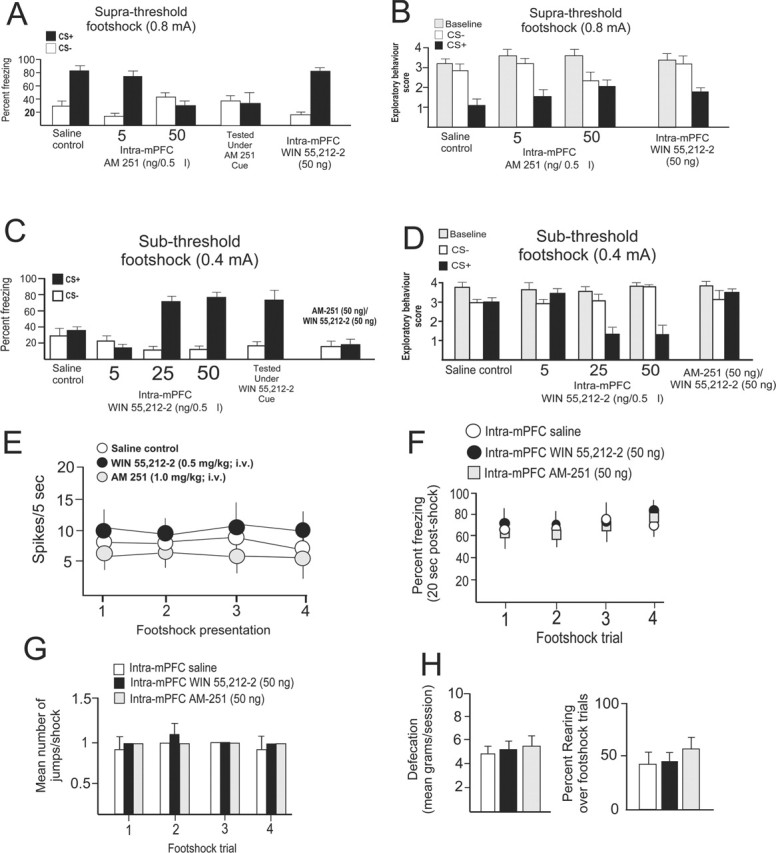Figure 7.

CB1 receptor activation or blockade in the mPFC modulates the behavioral expression of associative olfactory fear conditioning; the effects of intra-mPFC CB1 receptor modulation on neuronal and behavioral sensitivity to footshock presentation are shown. A, Rats show conditioned freezing behavior to an olfactory cue paired with a suprathreshold level of footshock (0.8 mA) 24 h after conditioning. Relative to saline controls, intra-mPFC microinfusions of AM-251 (50 ng/0.5 μl) before conditioning blocks olfactory fear conditioning relative to saline controls, whereas WIN 55,212-2 (50 ng/0.5 μl) has no effect on olfactory fear conditioning. Rats tested in the presence of intra-mPFC AM-251 (50 ng) still demonstrated a block in olfactory fear-conditioning expression, thus ruling out state-dependency effects. B, Similarly, AM-251 dose-dependently attenuates spontaneous exploratory behavior measures (see Materials and Methods) in response to CS+ odor presentations, whereas WIN 55,212-2 (50 ng) has no effect at this level of footshock (0.8 mA). C, A subthreshold level of footshock (0.4 mA) produces no fear conditioning in saline-pretreated control animals. However, intra-mPFC infusions of WIN 55,212-2 (25 or 50 ng/0.5 μl) potentiated the effects of this subthreshold level of footshock by enabling freezing to CS+ presentations relative to saline controls and a subthreshold dose of intra-mPFC WIN 55,212-2 (5 ng). This effect was blocked by simultaneous administration of the CB1 antagonist AM-251 (50 ng) with the highest effective dose of intra-mPFC WIN 55,212-2 (50 ng). Animals tested in the presence of intra-mPFC WIN 55,212-2 (50 ng) demonstrated strong olfactory fear-conditioning expression to subthreshold footshock, thus ruling out state-dependency effects. D, Subthreshold footshock failed to induce conditioned attenuation in exploratory behavior in response to postconditioning presentations of the CS+. However, in animals receiving intra-mPFC WIN 55,212-2 (25 or 50 ng), strong conditioned attenuation of exploratory behavior was observed during presentation of the CS+. This effect was blocked by coadministration of the CB1 antagonist AM-251 (50 ng) with the highest effective dose of intra-mPFC WIN 55,212-2 (50 ng). E, There were no significant differences in neuronal responsiveness in animals pretreated with effective systemic doses of either WIN 55,212-2 (0.5 mg/kg) or AM-251 (1.0 mg/kg). F, Bilateral intra-mPFC microinfusions of either WIN 55,212-2 (50 ng) or AM-251 (50 ng) produce no change in the percentage of freezing in response to suprathreshold footshock (0.8 mA) presentations during conditioning. G, H, Similarly, no differences were observed between intra-mPFC WIN 55,212-2 (50 ng) or AM-251 (50 ng) in terms of the number of jumps in response to footshock presentations (G) nor in the amount of defecation or in the percentage of animals displaying rearing behavior in response to footshock (H). Error bars indicate mean ± SEM.
